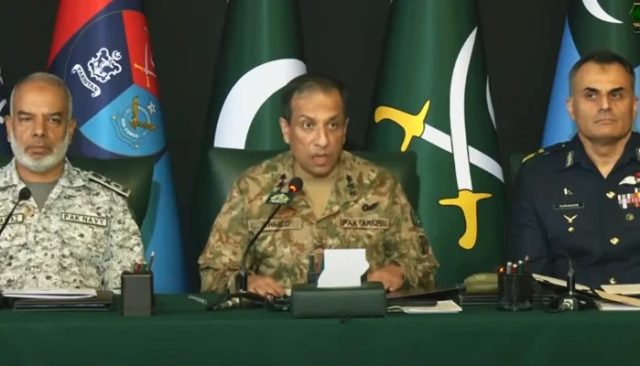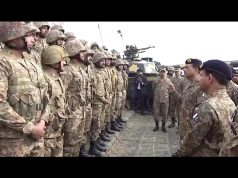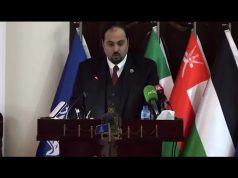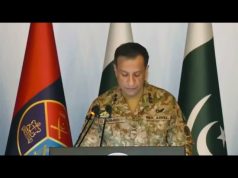RAWALPINDI, Sunday, May 11, 2025 (WNP): Pakistan’s top military spokesperson, Lieutenant General Ahmed Sharif Chaudhry, on Sunday issued a stern warning against any threat to the country’s sovereignty, asserting that any violation of territorial integrity would be met with a “comprehensive, retributive and decisive” response.
Addressing a high-profile press conference flanked by Air Vice Marshal Aurangzeb Ahmed and Vice Admiral Raja Rab Nawaz, the Director General of the Inter-Services Public Relations (DG ISPR) laid out the scope and scale of Operation Bunyan Al Marsoos—Pakistan’s coordinated military response to recent Indian aggression.
Massive retaliatory strikes across borders
Lt Gen Chaudhry disclosed that Pakistan had struck 26 high-value military targets across Indian Illegally Occupied Jammu and Kashmir (IIOJK) and mainland India. These included airbases, missile facilities, logistic hubs, and command centers directly linked to attacks on Pakistani civilians and acts of cross-border terrorism.
Notable targets included Indian Air Force installations at Suratgarh, Sirsa, Adampur, Bhuj, Nalia, Bathinda, Barnala, Avantipura, Srinagar, Jammu, Ambala, Udhampur, and Pathankot—all reported to have sustained significant damage. Facilities involved in launching BrahMos missiles and the S-400 missile battery systems at Adampur and Bhuj were also destroyed.
“Our operations were carried out with precision. Entities involved in supporting or planning terrorist operations inside Pakistan were neutralized,” said the DG ISPR, noting the destruction of command brigades at KG Top and Nowshera and supply depots at Uri and Poonch.
He added that Pakistan’s forces struck artillery and military outposts responsible for unprovoked shelling across the Line of Control (LoC), forcing enemy positions to raise white flags.
Tri-services synergy & technological superiority
Describing the operation as a “textbook example” of tri-services coordination, Lt Gen Chaudhry emphasized the fusion of air, land, sea, cyber, and space capabilities, driven by real-time intelligence and network-centric warfare tools.
Precision strikes were carried out using Fateh-series missiles, loitering munitions, long-range artillery, and smart air-delivered munitions. He highlighted the use of advanced unmanned platforms, stating that dozens of Pakistani drones flew over major Indian cities, including New Delhi, demonstrating Pakistan’s long-range ISR and strike capabilities.
Additionally, a comprehensive cyber offensive was launched to degrade Indian military infrastructure temporarily, showcasing the breadth of Pakistan’s technological arsenal.
No civilian targets, no ceasefire requested
Lt Gen Chaudhry underscored that Pakistan did not target civilians. “Our religion, our culture, and our military professionalism forbid us from doing so,” he said. “Even Indian officials could not allege that we hit anything other than military targets.”
He clarified that Pakistan never requested a ceasefire, dismissing reports to the contrary as misinformation. “Following the Indian attacks on May 6-7, it was India that sought de-escalation,” he said. “Pakistan responded only after delivering a decisive and proportionate reply.”
He also debunked rumors about Indian pilots being captured, calling it “social media chatter” and “disinformation.”
India’s attempts to escalate foiled
Air Vice Marshal Aurangzeb Ahmed elaborated on the Pakistan Air Force’s (PAF) role in neutralizing Indian threats. He said the PAF targeted more IAF airfields in a single coordinated mission than at any time since 1971, carefully avoiding collateral damage.
“India attempted to create a new normal through aggression. We stopped that dead in its tracks,” he asserted.
He credited the strategic leadership of Chief of Air Staff Air Chief Marshal Zaheer Ahmad Babar, who assigned three clear objectives: restore deterrence, neutralize threats, and maintain air superiority.
Aurangzeb revealed that Pakistani radar and jamming systems disabled dozens of Indian drones, while Rafale fighter squadrons were grounded early in the operation, limiting India’s aerial options.
Navy maintains vigilance, deters carrier threat
Vice Admiral Raja Rab Nawaz addressed maritime security, revealing that the Indian aircraft carrier INS Vikrant, which was reportedly advancing toward Pakistani waters, never breached a 400-nautical-mile threshold off the coast of Karachi.
“We tracked it from the beginning,” he said. “The Navy was fully prepared. Had it moved closer, it would have faced swift and decisive retaliation.”
He pointed out that INS Vikrant’s limited air capability made it more symbolic than strategic. “The Indian Navy knew the cost of escalation at sea,” he said, adding that Pakistan ensured all ports remained fully operational during the crisis.
Terrorism spike from western borders
Lt Gen Chaudhry also revealed that while Pakistan was engaged on its eastern front, it faced an unprecedented surge in Indian-backed terrorist activity in Khyber Pakhtunkhwa and Balochistan. “This validates what we’ve long said: India is actively sponsoring terrorism in Pakistan,” he stated.
Despite these provocations, the military simultaneously conducted highly effective counterterrorism operations in the western region without diverting focus from the eastern front.
Nation stands united
The DG ISPR expressed gratitude to the armed forces, the Pakistani public, political leadership, and media for their unwavering support during the crisis.
He hailed the youth of Pakistan as frontline cyber warriors and praised the media’s role in countering Indian disinformation. “You stood like a steel wall—Bunyan Al Marsoos—against a hostile narrative,” he said.
He also lauded the Prime Minister and Cabinet for taking bold decisions during the escalation, steering the country with maturity and resolve.
“We had promised the nation a decisive response. We delivered—on our terms, at our time, and with such clarity that the world took notice,” he concluded. “In the face of aggression, we acted with restraint, maturity, and overwhelming strength. There is no room for war between nuclear neighbors, only space for peace through deterrence.”




